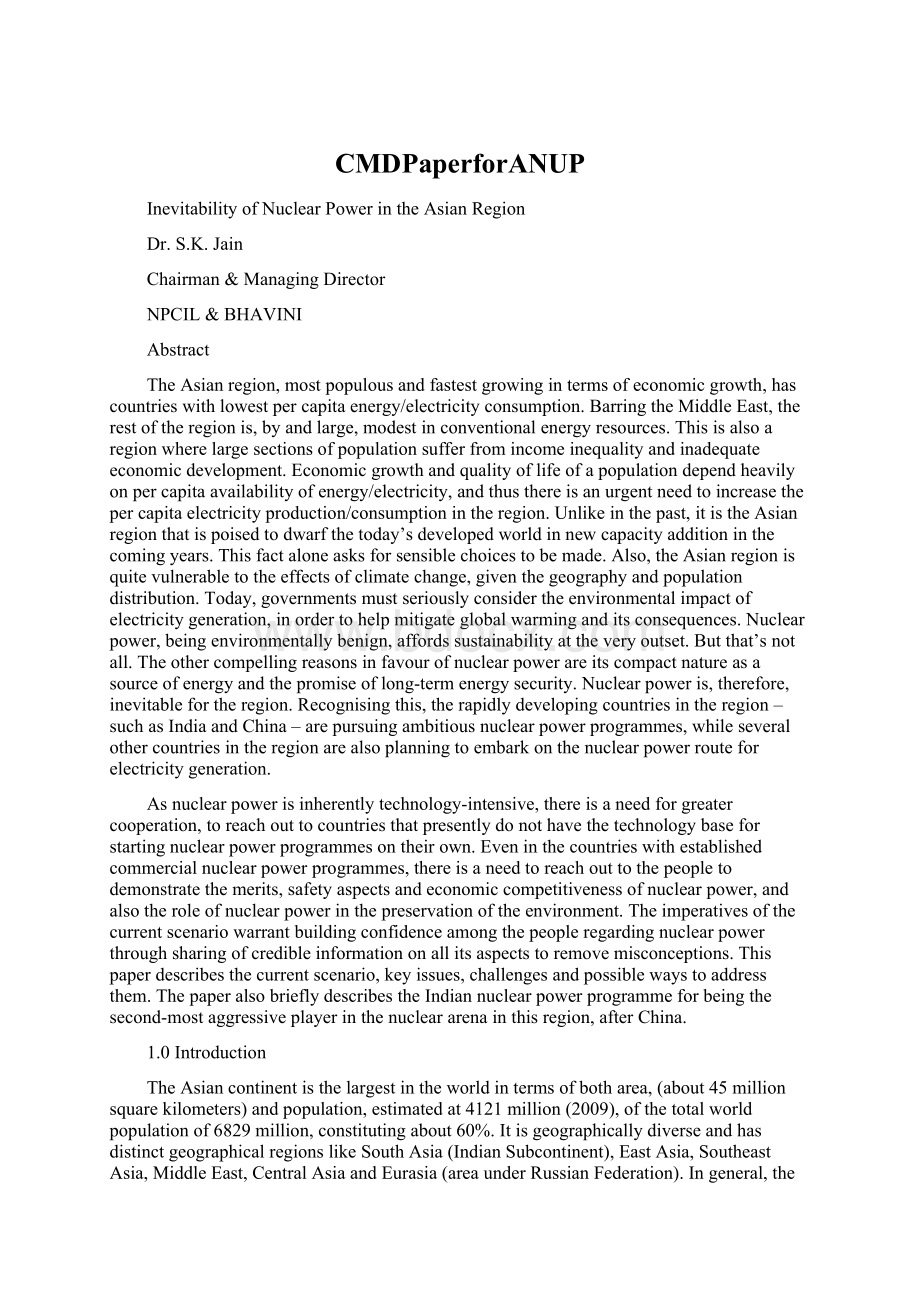CMDPaperforANUP.docx
《CMDPaperforANUP.docx》由会员分享,可在线阅读,更多相关《CMDPaperforANUP.docx(23页珍藏版)》请在冰豆网上搜索。

CMDPaperforANUP
InevitabilityofNuclearPowerintheAsianRegion
Dr.S.K.Jain
Chairman&ManagingDirector
NPCIL&BHAVINI
Abstract
TheAsianregion,mostpopulousandfastestgrowingintermsofeconomicgrowth,hascountrieswithlowestpercapitaenergy/electricityconsumption.BarringtheMiddleEast,therestoftheregionis,byandlarge,modestinconventionalenergyresources.Thisisalsoaregionwherelargesectionsofpopulationsufferfromincomeinequalityandinadequateeconomicdevelopment.Economicgrowthandqualityoflifeofapopulationdependheavilyonpercapitaavailabilityofenergy/electricity,andthusthereisanurgentneedtoincreasethepercapitaelectricityproduction/consumptionintheregion.Unlikeinthepast,itistheAsianregionthatispoisedtodwarfthetoday’sdevelopedworldinnewcapacityadditioninthecomingyears.Thisfactaloneasksforsensiblechoicestobemade.Also,theAsianregionisquitevulnerabletotheeffectsofclimatechange,giventhegeographyandpopulationdistribution.Today,governmentsmustseriouslyconsidertheenvironmentalimpactofelectricitygeneration,inordertohelpmitigateglobalwarminganditsconsequences.Nuclearpower,beingenvironmentallybenign,affordssustainabilityattheveryoutset.Butthat’snotall.Theothercompellingreasonsinfavourofnuclearpowerareitscompactnatureasasourceofenergyandthepromiseoflong-termenergysecurity.Nuclearpoweris,therefore,inevitablefortheregion.Recognisingthis,therapidlydevelopingcountriesintheregion–suchasIndiaandChina–arepursuingambitiousnuclearpowerprogrammes,whileseveralothercountriesintheregionarealsoplanningtoembarkonthenuclearpowerrouteforelectricitygeneration.
Asnuclearpowerisinherentlytechnology-intensive,thereisaneedforgreatercooperation,toreachouttocountriesthatpresentlydonothavethetechnologybaseforstartingnuclearpowerprogrammesontheirown.Eveninthecountrieswithestablishedcommercialnuclearpowerprogrammes,thereisaneedtoreachouttothepeopletodemonstratethemerits,safetyaspectsandeconomiccompetitivenessofnuclearpower,andalsotheroleofnuclearpowerinthepreservationoftheenvironment.Theimperativesofthecurrentscenariowarrantbuildingconfidenceamongthepeopleregardingnuclearpowerthroughsharingofcredibleinformationonallitsaspectstoremovemisconceptions.Thispaperdescribesthecurrentscenario,keyissues,challengesandpossiblewaystoaddressthem.ThepaperalsobrieflydescribestheIndiannuclearpowerprogrammeforbeingthesecond-mostaggressiveplayerinthenucleararenainthisregion,afterChina.
1.0Introduction
TheAsiancontinentisthelargestintheworldintermsofbotharea,(about45millionsquarekilometers)andpopulation,estimatedat4121million(2009),ofthetotalworldpopulationof6829million,constitutingabout60%.ItisgeographicallydiverseandhasdistinctgeographicalregionslikeSouthAsia(IndianSubcontinent),EastAsia,SoutheastAsia,MiddleEast,CentralAsiaandEurasia(areaunderRussianFederation).Ingeneral,theMiddleEastandEurasiaarereferredtoseparately,whiletheAsianregionpredominantlyreferstotheremainingareasofthecontinent.
Ithasthetwobiggestcountriesintermsofpopulation,ChinaandIndia,whichconstituteabout37%oftheworldpopulation.Alargepopulationoftheregionhasaverylowpercapitaincomeofabout$3000(PPP).Inviewofthis,manyofthecountiesintheAsianregionrankverylowonthehumandevelopmentindex(HDI).However,thedevelopmentgoalsofthecountriesintheregionneedthemtobeonapathofrapideconomicgrowth.Thevariouspoliciesofmostnationsoftheregionaredirectedatensuringafasteconomicgrowthratetoachievetheirdevelopmentgoals.
ChinaandIndiaaretheworld’ssecond-andthird-largesteconomiesinPurchasingPowerParity(PPP)terms.Theyarealsoamongthefastest-growingeconomies,growingataround7to10%everyyear.TheothereconomiesinEastandSoutheastAsiaarealsogrowingequallyatrapidrates.
Settingupinfrastructure,particularlywhichofenergy/electricityisoneofmainrequirementsforensuringsustainedeconomicgrowthintheregion.
2.0PresentEnergy/ElectricityScenariointheAsianRegion
Theenergy/electricityconsumptionpatternsvaryacrosstheAsianregiondependingonthespectrumofeconomyandthemodelsspecifictoeachofthecountry,thecurrentpolicies,demographicpatternaswellasindustrialandagriculturebase,etc.Whiletheelectricityconsumptionindevelopednationsoftheregion,suchasJapan(8475kWh)andKorea(8502kWh),ishigh,beingclosetoEuropeancountries,itisquitelowintherangeof80to700kWhincountriesofSouthAsia.About22%ofthepopulation(900millionpeopleofthe4121million)intheregiondoesnothaveaccesstoelectricity.Ofthese,themajority,about700millionarelocatedinSouthAsia.ThegraphsbelowshowtherangeofpercapitaenergyandelectricityconsumptioninsomeoftheAsiancountries:
Fig.1PerCapitaPrimaryEnergySupply
Source:
KeyWorldEnergyStatistics2009,IEA
Fig.2.PerCapitaPrimaryElectricityConsumption
Theothersignificantfeatureoftheenergysupplypatterninthecountriesoftheregionisalargecontributionofnon-commercialenergy–intheformoffirewood,agriculturalandfarmresidue,etc.Themainsourcesofcommercialenergyintheregionarecoal(41%)andOil(28%).
Theoverallimportdependencyoftheregionissignificant,particularlyforoil,atabout57%(2005).ThedependencyonimportsforoilinIndiaisabout75%.Energysecurityintheregionisoneoftheconcernsintheregionandthereisanimminentneedtoaddressthis,whichcouldbeachievedbydeployingsustainablesourcesofenergy.Thishasresultedinnuclearpowergettingseriousattentionandconsiderationasoneofthepreferredoptionsamongtheotherenergysourcesintheregion.
2.1DemandProjections:
Thedemandforprimaryenergyintheregionisprojectedtogrowatabout2.4%peryear,withelectricitydemandgrowingat3.5%peryear.China(45.5%)andIndia(17.2%)areexpectedtoconstituteabouttwo-thirdsoftheregion’selectricitygenerationbytheyear2030.
InIndia,theprojectionsofenergyandelectricityupto2032havebeenmadeinIntegratedEnergyPolicy(2005)andthesearebasedonfallingelasticityrateswithassumedGDPgrowthratesof8%and9%.Theaveragegrowthrateofprimarycommercialenergyandelectricityareestimatedtobe5%and7%respectively.Theprojectedenergyandelectricityrequirementsbytheyear2032are1531mtoeand1823mtoefor8%and9%growthratesrespectively.Thecorrespondingelectricityrequirementsareestimatedat3880and4806Terawatt-hours(billonkWh),whichtranslatestoinstalledcapacitiesof778GWand960GWby2032respectively.
ThereareseveralstudiesmadeonChina’sdemandprojectionsovervaryingtimeframes.TheIEAWorldEnergyOutlook2007studyprojectsChina’stotalenergyrequirementby2030at3819mtoeinoneofthescenarios.ThestudyprojectsChina’selectricityrequirementin2030at8472billionkWh.Thecorrespondinginstalledcapacityforanaveragegrowthrateof7.5%isestimatedabout1775GWby2030.
2.2EnergyResources–CurrentPosition
Theenergyresourcesintheregionsaredistributedmostunevenly.Coalisthemainsourceofcommercialenergyintheregion,availableinChina,India,Indonesiaandsomeothercountries.TheoilandgasresourcesareavailableinCentralAsiaandSoutheastAsia.However,theregionisanetimporterofoil.
Theincreaseddemandoverthenexttwodecadeswillincreasetheimportdependency,apartfromincreaseinexploitationoftheseresourcesfromwithintheregion.
Hydropowerandrenewableenergyhassignificantpotentialinsomecountriesoftheregion.However,theshareofthesesourcesinthetotalprimaryenergydemandislikelytoremainlow.
Atpresent,nuclearpowerislimitedtoafewcountriesintheregioninJapan,SouthKorea,China,India,PakistanandTaiwan.However,projectionsshowamanifoldincreaseofnuclearpowerinChinaandIndiaandothercountrieshasplannedtostartthesame.Thenon-renewableresourceprofilesforcountriesoftheregionthathavesubstantialreservesaregivenbelow:
Fig.3CoalreservesincountriesofAsianRegion
Fig.4OilreservesincountriesofAsianRegion
Fig.5GasreservesincountriesofAsianRegion
Source:
BPStatisticalReview2009
Fig.6UraniumreservesincountriesofAsianRegion
Source:
WNA
Theresourceprofilesoftwoofthemostpopulousnations,ChinaandIndia,andtheirreserves-to-productionratioattheendof2008aregivenbelow:
Table1:
China&IndiaFossilFuelReserves
Resource
China
India
Reserves
R/PRatio
Reserves
R/PRatio
Coal(billiontons)
115
41
59
115
Oil(billionbarrels)
15
11
5.8
21
Gas(trillioncu.m)
2.46
32
1.09
36
Source:
BPStatisticalreview2009
AlthoughChinahaslargeresources,therapidrateofexploitationhasrendereditanetimporterofenergy.Itsimportdependencygrewfrom-4.1%in1990to7.2%in2006.
Similarly,India’srateofproductionofcoalisgrowingatabout5%,atwhichratethemineableresourceofcoalcouldbeexhaustedinabout40years.Thusthetwocountrieshavelimitationsonfossilfuelsthatcanbeeconomicallyminedbeyondthemediumterm.
2.3SustainabilityIssues:
2.3.1EnergySecurity
Theadditionofcapacityintheregionisprojectedtobelargelycommensuratewiththeeconomicgrowth.AseachkWhgeneratedfromfossilfuelemitsaboutakgofCarbondioxide(directemissio